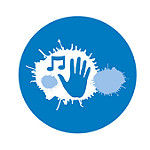 [Editor’s note: guest post written by Louise Bardgett, Art of Libraries project manager]
[Editor’s note: guest post written by Louise Bardgett, Art of Libraries project manager]
Six months down the line
Ten months ago, I started as Project Manager for a new flagship project, Art of Libraries (AoL) in Gloucestershire, taking on a different and innovative challenge of setting up and managing a three year pilot involving six libraries spread geographically across the county.
Libraries have always been close to my heart, from leading my first parents and tots dance and storytime sessions in Winsford Library, where I was based with Cheshire Dance Workshop, to taking my own children to our local library in Coventry. Twenty years later, and having been involved in the life changing Creative Partnerships programme as a Programme Manager and Change Agent, it is incredible to now be working on such a potentially influential prototype project to test a new recipe for cultural education.
“I tend to not think about AoL as a project but rather a journey of change for the library. A journey that seeks to alter perceptions about what a library is, what it can offer and the impact that it can have within a community”. (Creative Catalyst)
Art of Libraries is an exciting test project led by Create Gloucestershire in partnership with Gloucestershire Libraries and Information, the Barnwood Trust and Real Ideas Organisation. With support from Esmee Fairbairn Foundation, Arts Council England, Ernest Cook Trust, the Summerfield Trust and other local community funds over three years, the goal is to develop libraries as hubs for introducing arts and culture to children and young people especially those who do not currently engage with the sector. Gloucestershire is an interesting mix of urban and rural geographies, affluence and social inclusion across the county’s six districts, with pockets of persistent deprivation located in the inner urban areas of Cheltenham and Gloucester, but also in rural areas such as the Forest of Dean. The selected libraries are spread geographically across the county, all connected with a neighbouring arts venue or organisation.
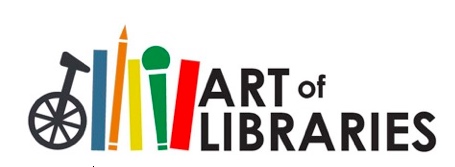
Create Gloucestershire (CG) is a network of over 570 individuals, organisations, producers, groups and venues each of whom explore and understand in diverse ways the potential of art, culture and creative industries to transform individual lives and places. CG is driven by a question - what would Gloucestershire be like if arts, culture and creativity were part of everyday life, for everyone?
CG is a non-profit organisation set up in 2011 by a group of six arts leaders, as the “honest broker” to help work out whether they could secure more funding if they fundraised together rather than individually. Since then, our work always starts with a question or an opportunity that matters to somebody. CG is a creative catalyst bringing the right combination of people together, and drawing on their unique talents and assets, to come up with a creative and innovative response.
Creating an arts and culture hub
We have four early adopter libraries (increasing to six in year two) where we are doing a re-think and a “refresh” – weaving arts and cultural activity (everything from Virtual Reality, GPS embroidery, coding, music) with activities more associated with a library such as storytelling and reading. The goal is a change in mindsets so libraries aren’t just seen as a “hush” space, but a
place to play, experiment and be creative.
Re-imagining cultural education in Gloucestershire
A vital starting point is growing cultural “habits” from a very early stage in life so that children grow up with art and culture as “every day”. Art of Libraries sits within this context as a re-imagination of cultural education in Gloucestershire. This is a story of change that will need to unfold across a range of urban and rural geographies, engaging the hearts and minds of a wide cross section of the population.
A co-produced approach to creating change
There are artists working as change agents (our Creative Catalyst team) in each library, building relationships, discovering what does and doesn’t work and sharing this with a whole set of people. With an interesting mix of backgrounds, skillsets and producing experience connected to Blast Theory and Watershed’s Pervasive Media Studio to aerial and outdoor performance work, they are the vital catalyst to this new way of working. With a blend of leadership and facilitation, mentoring and enabling, the Creative Catalysts (CC) build capacity and confidence within the team of library staff so that we are able to explore if our change model can become “business as usual” when the funding ends.
Six months down the line, we are just starting to see the value of this new role – which is not just about brokering partnerships or developing new activity but, more importantly, giving permission to do things differently. It is about creating change and a new culture and model for the library service.
Each CC works alongside the library staff; enabling, enthusing, questioning, agitating, opening up new possibilities. In some cases, they are seen as the “go to person”, when you have a good idea. It seems to be an ever-changing role, with plenty of ups and downs along the way.
“The staff like trying new things, but it’s having the confidence to carry on when it doesn't work out first time ... their autonomy is like a blank canvas. It is refreshing to experience this and their “can do” attitude helps empower staff.” (Library team leader on the role of the Creative Catalyst)
I have been surprised how each library operates, with its own set of personalities, dynamics and needs. The challenge for the CC is to help the library staff identify these needs and gaps, and tackle these barriers to creative engagement head on, opening up new possibilities through mutual points of interest. Finding innovative and creative ways to re-engage young adults is a common thread across all four libraries this year.
Changing perceptions of the library
A key task is changing perceptions about what the library can offer by connecting people and organisations through an exchange of skills, space and building a two-way relationship. It may be as simple as offering space for the local youth group to meet once a month for a teen takeover, or providing a large screen for a gaming club to play together on a Friday after school, as a platform for developing an alternative storytelling programme for teenagers.
“I feel as though someone has lit the touch paper and set off an enormous firework! The thought of solving a ‘library’ problem via AoL is fantastic and now is exactly the right time to make a start. “(Operations and Development Manager, Glos Libraries & Info)
A good example of change comes from Dursley Youth Forum, who felt the books on offer at the library were not appropriate for their age group. In response, the Library offered the young people control over a significant stock budget of £1000 as well as the offer of hosting future meetings in the library. ‘Hush Hush’ has also been launched - an online digital space specifically for young people to play and share things happening in the town.
Coleford Library has set up a new Shadowing project, encouraging young adults and children to come together to discuss books shortlisted for the Carnegie and Kate Greenaway awards for Children’s literature. Reading groups have been started in Years 7 and 8 at a local secondary school to discuss books and building in librarian time, pupils are coming up with their own creative responses to the books through drawing, animation, etc. The next step is to link into Coleford Festival of Words over the summer, allowing the young people to celebrate and share their work and gain an Arts Award.
Multiple roles of a Creative Catalyst
The CC is a skilled community developer, tapping into local networks, ideas and interests and getting under the skin of what is currently happening in the locality. In Tewkesbury, the CC has been encouraging the town to see the library as a key partner for funding bids, events and town wide creative and heritage programmes such as their recent involvement in the Tewkesbury Big Weekend and plans for the 20:21 heritage project.
Through a careful blend of mentoring, enabling, listening and problem solving skills, each CC has uncovered what the team needed to help things change from within, and to give permission to give things a go without the worry of failure. Working one day a week, with mainly part time library staff, has its challenges. Encouraging and empowering library staff to have ideas which interest and excite them has taken time, but we are already seeing glimmers of increased confidence, leadership and potential for sustainability beyond the life of the project.
Sometimes that encouragement needs to start small; something that is realistic and achievable. A recent training session on storytelling ideas for early years children and families with Playcircle, resulted in the library staff having the confidence to lead a special interactive story time during the Big Weekend event in Tewkesbury.
Moving from consumers to producers
The shift from consumers to producers is starting to happen, expanding expectations of what you can do in a library and staff being able to respond positively to requests. A children’s creative writing group arose from an initial enquiry from a young child at Tewkesbury library.
Engaging parents and community volunteers to provide a scaffold to support longevity of activities on offer has been vital, such as setting up a creative STEM/code club facilitated by a parent in Coleford Library. Encouraged to work in a socially enterprising way, the CC’s are more alert to identifying and matching skills of library staff, local artists and members of the community. A local musician had been given seed funding by a local charity to run a music tech jam club; with additional support, space and reassurance from the CC, he has been able to get this idea off the ground at Coleford Library.
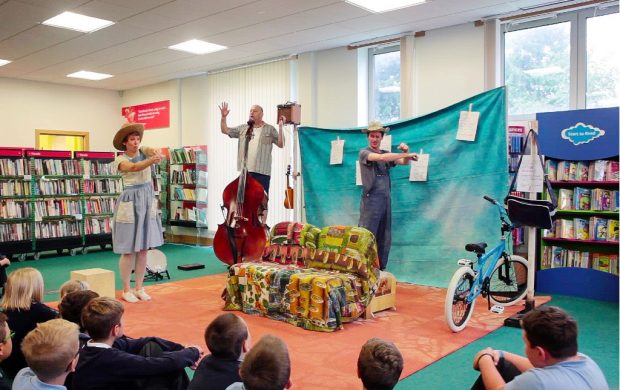
Libraries as ‘trusted spaces’
Libraries need to be seen as trusted civic spaces. Encouraging young people to feel ownership of the space takes mutual respect and time. This new found confidence was demonstrated recently when one young person who has visited the library a couple of times with his youth group, came into the library to ask directions.
They also need to be seen as welcoming spaces, a hive of activity. The people of Dursley built a new version of their town out of cardboard. Library users were asked "what would be the most important thing to exist in their town if they were in control?" The answers varied from restaurants to football stadiums, water works, wind farms and skate parks and all were then made from boxes and tape. The sprawling town existed in the library for a day, facilitated by Amy Rose, artist and immersive storyteller.
“This is what the library should be for, lots of families, interaction, more of a group buzz”. (Parent)
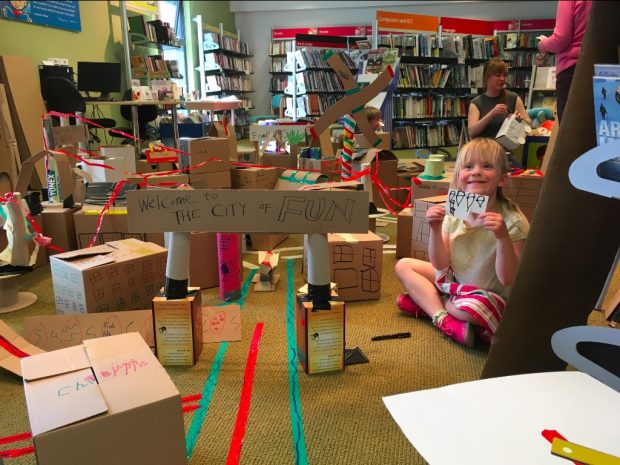
One size does not fit all
In some libraries, it has been more of a slow burner with effective, sustainable change taking place gradually over time. It takes confidence not to rush into setting up activity but allowing time for things to grow organically with a shared sense of ownership. The challenge is balancing the enthusiasm and energy of experienced producers/Creative Catalysts alongside the slower day-to-day rhythms of each library and personalities of mainly part-time staff.
Is it really still Year One?
Art of Libraries is a pilot project over three years. We are now over half way through our first year and looking forward to planting lots of different seeds, ready to cultivate in year two. Our aim for now is about changing perceptions, both within the library and out in the community and widening the scope of what is possible. In a recent review, library staff were starting to talk about risk taking, permission and opportunities to play, demonstrating the positive and creative potential for libraries
in Gloucestershire. Permission to try things out is vital to this project; it is not about always getting it right, but critically learning from it.
“It sometimes feels like we are drivers without a map ... however this way of working is a gift ... we are trailblazers and we are creating the map, rather than following something already mapped out and this is both nerve wracking and exciting!” (CC)
It has been a roller coaster of a journey, keeping people on track and ensuring they come on this journey of discovery with us. Supported by a Prove and Improve framework, it has been vital to create a culture of honesty and reflection for everyone involved. There are plenty of things I have learnt along the way and continue to be surprised by.
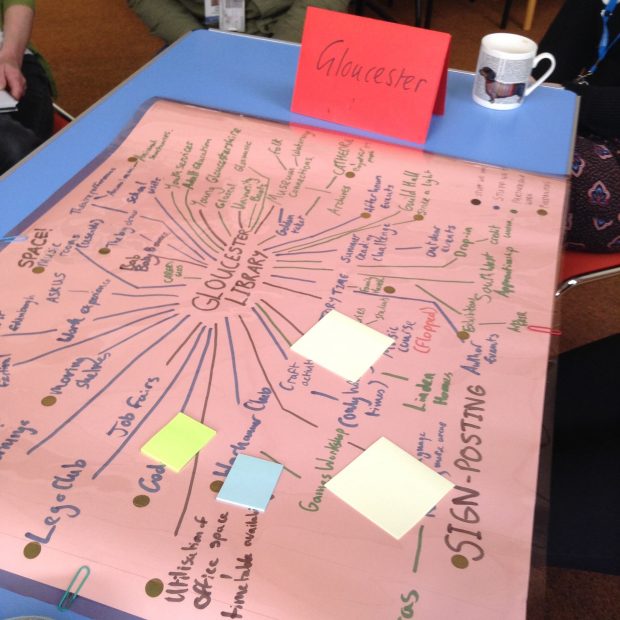
If you are interested in discovering more about the AoL journey, ways you can be involved or want
to share your experiences as an artist working in libraries, or work in a library using arts and culture, then join our conversation at #Artoflibraries
Have a look at what is happening in other areas. We’re interested in Libraries Unlimited in the South West and St.Helens Cultural Hubs.
Or contact Louise Bardgett, Art of Libraries Project Manager louise@creategloucestershire.co.uk
------------------------------------------
Please note, this is a guest blog. Views expressed here do not necessarily represent the views of DCMS or the Libraries Taskforce